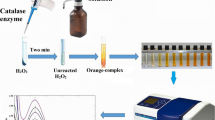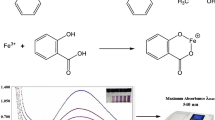Abstract
This article presents a reliable, effective and easy procedure for measuring glutathione peroxidase (Gpx) activity. Enzyme samples were incubated with phosphate buffer, which included the appropriate concentrations of glutathione (GSH) and peroxide as substrates, to determine Gpx activity. In the CUPRAC method, the CUPRAC reagent Cu(Nc)22+ was added to stop the enzymatic reaction after a sufficient period of incubation. The unreacted substrates acted to reduce the Cu(II)–neocuproine complex into the strongly coloured Cu(I)–neocuproine complex that could be measured spectrophotometrically at 450 nm. GPx activity was linked to a decrease in the absorbance of the coloured Cu(I)–neocuproine complex. The Box–Behnken design was used to optimise the formation of the Cu(I)–neocuproine complex. Response surface methodology was applied to determine the accuracy of the method. This new protocol was confirmed by performing the Bland–Altman plot analysis of Gpx activity in matched samples through the Gpx–DTNB assay. The correlation coefficient between the two protocols was 0.9967. This result indicated that the new protocol was very accurate and on par with the comparison method.
Graphic abstract









Similar content being viewed by others
References
Ali MJ, Guesmi F, Harrath AH, Alwasel S, Hedfi A, Ncib S, Landoulsi A, Aldahmash B, Ben-Attia M (2015) Investigation of antiulcer and antioxidant activity of Juniperus phoenicea L.(1753) essential oil in an experimental rat model. Biol Pharma Bull 38(11):1738–1746
Alptekin Ö, Tükel SS, Yıldırım D, Alagöz D (2010) Immobilization of catalase onto Eupergit C and its characterization. J Mol Catal B Enzym 64(3–4):177–183
Altay A, Kartal Dİ, Sadi G, Güray T, Yaprak AE (2017) Modulation of mRNA expression and activities of xenobiotic metabolizing enzymes, CYP1A1, CYP1A2, CYP2E1, GPx and GSTP1 by the Salicornia freitagii extract in HT-29 human colon cancer cells. Arch Biol Sci 69(3):439–448
Austin L, Arthur H, de Niese M, Gurusinghe A, Baker MS (1988) Micromethods in single muscle fibers: 2. Determination of glutathione reductase and glutathione peroxidase. Anal Biochem 174:575–579
Bahar B, Tuncel AF, Holmes EW, Holmes DT (2017) An interactive website for analytical method comparison and bias estimation. Clin Biochem 50(18):1025–1029
Baltić MŽ, Starčević MD, Bašić M, Zenunović A, Ivanović J, Marković R, Janjić J, Mahmutović H (2015) Effects of selenium yeast level in diet on carcass and meat quality, tissue selenium distribution and glutathione peroxidase activity in ducks. Anim Feed Sci Technol 1(210):225–233
Brigelius-Flohé R, Flohé L (2020) Regulatory phenomena in the glutathione peroxidase superfamily. Antioxid Redox Signal 33(7):498–516
Chafik A, Essamadi A, Çelik SY, Solak K, Mavi A (2018) Partial purification and some interesting properties of glutathione peroxidase from liver of camel (Camelus dromedarius). Russ J Bioorg Chem 44(1):41–51
Chang C, Worley BL, Phaëton R, Hempel N (2020) Extracellular glutathione peroxidase GPx3 and its role in cancer. Cancers 12(8):2197
Cichoski AJ, Rotta RB, Scheuermann G, Cunha Junior A, Barin JS (2012) Investigation of glutathione peroxidase activity in chicken meat under different experimental conditions. Food Science and Technology 32:661–667
Committee for Medicinal Products for Human Use. Guideline on bioanalytical method validation. European Medicines Agency. 2011 Jul.
Ferreira SC, Bruns RE, Ferreira HS, Matos GD, David JM, Brandao GC, da Silva EP, Portugal LA, Dos Reis PS, Souza AS, Dos Santos WN (2007) Box-Behnken design: an alternative for the optimization of analytical methods. Anal Chim Acta 597:179–186
Flohé L, Günzler WA (1984) Assays of glutathione peroxidase. Methods Enzymol 1(105):114–120
Giavarina D (2015) Understanding bland altman analysis. Biochemia Medica 25(2):141–151
Guo X, Yu Y, Liu X, Zhang Y, Guan T, Xie G, Wei J (2014) Heterologous expression and characterization of human cellular glutathione peroxidase mutants. IUBMB Life 66(3):212–219
Ichihara K, Hosogaya S, Okutani R, Yoshimoto S, Itoh K, Kameko M, Kayamori Y, Takagi Y, Nakano Y, Haga R, Motonaga H (2006) Protocols of determining limits of detection and limits of quantitation for quantitative analytical methods. Jpn J Clin Chem 35(3):280–294
Kamata T, Akasaka K, Ohrui H, Meguro H (1994) Fluorometric assay of glutathione peroxidase activity in liver and plasma with N-(9-acridinyl) maleimide. Biosci Biotechnol Biochem 58(5):878–880
Koontz L (2014) TCA precipitation. Methods Enzymol 1(541):3–10
Lawrence RA, Burk RF (1976) Glutathione peroxidase activity in selenium-deficient rat liver. Biochem Biophys Res Commun 71(4):952–958
Maiorino M, Bosello V, Cozza G, Roveri A, Toppo S, Ursini F. Glutathione peroxidase-4. In Selenium 2011 (pp. 181–195). Springer, New York, NY.
Martinez JI, Launay JM, Dreux C (1979) A sensitive fluorimetric microassay for the determination of glutathione peroxidase activity. Application to human blood platelets. Anal Biochem 98(1):154–159
Massa CM, Liu Z, Taylor S, Pettit AP, Stakheyeva MN, Korotkova E, Popova V, Atochina-Vasserman EN, Gow AJ (2021) Biological mechanisms of S-nitrosothiol formation and degradation: how is specificity of S-nitrosylation achieved? Antioxidants 10(7):1111
Nunes CA, Freitas MP, Pinheiro AC, Bastos SC (2012) Chemoface: a novel free user-friendly interface for chemometrics. J Braz Chem Soc 23(11):2003–2010
Orian L, Mauri P, Roveri A, Toppo S, Benazzi L, Bosello-Travain V, De Palma A, Maiorino M, Miotto G, Zaccarin M, Polimeno A (2015) Selenocysteine oxidation in glutathione peroxidase catalysis: an MS-supported quantum mechanics study. Free Radical Biol Med 1(87):1–4
Orian L et al (2018) The catalytic mechanism of glutathione peroxidases in Glutathione. In: Flohé L (ed) Series Oxidative stress and disease. CRC Press, pp 53–66
Özyürek M, Güçlü K, Apak R (2011) The main and modified CUPRAC methods of antioxidant measurement. Trends Anal Chem (TrAC) 30(4):652–664
Paglia DE, Valentine WN (1967) Studies on the quantitative and qualitative characterization of erythrocyte glutathione peroxidase. J Lab Clin Med 70(1):158–169
Payne RB (1997) Method comparison: evaluation of least squares, deming and passing/Bablok regression procedures using computer simulation. Ann Clin Biochem 34(3):319–320
Piggott AM, Karuso P (2007) Fluorometric assay for the determination of glutathione reductase activity. Anal Chem 79(22):8769–8773
Qi X, Ng KT, Lian Q, Li CX, Geng W, Ling CC, Yeung WH, Ma YY, Liu XB, Liu H, Liu J (2018) Glutathione peroxidase 3 delivered by hiPSC-MSCs ameliorated hepatic IR injury via inhibition of hepatic senescence. Theranostics 8(1):212
Rajalingam D, Loftis C, Xu JJ, Kumar TK (2009) Trichloroacetic acid-induced protein precipitation involves the reversible association of a stable partially structured intermediate. Protein Sci 18(5):980–993
Rover L Jr, Kubota LT, Höehr NF (2001) Development of an amperometric biosensor based on glutathione peroxidase immobilized in a carbodiimide matrix for the analysis of reduced glutathione from serum. Clin Chim Acta 308:55–57
Ryan S, Bacon H, Endenburg N, Hazel S, Jouppi R, Lee N, Seksel K, Takashima G (2019) WSAVA animal welfare guidelines. J Small Anim Pract 60(5):E1-46
Schomburg I, Jeske L, Ulbrich M, Placzek S, Chang A, Schomburg D (2017) The BRENDA enzyme information system—from a database to an expert system. J Biotechnol 10(261):194–206
Szczeklik K, Krzysciak W, Domagala-Rodacka R, Mach P, Darczuk D, Cibor D, Pytko-Polonczyk J, Rodacki T, Owczarek D (2016) Alterations in glutathione peroxidase and superoxide dismutase activities in plasma and saliva in relation to disease activity in patients with Crohn’s disease. J Physiol Pharmacol 1(67):709–715
Ugar M, Tufan AN, Altun M, Guclu K, Ozyurek M (2018) Glutathione peroxidase activity of biological samples using a novel microplate-based method. Curr Anal Chem 14(5):512–518
Wang R, Yang Z, Zhang J, Mu J, Zhou X, Zhao X (2019) Liver injury induced by carbon tetrachloride in mice is prevented by the antioxidant capacity of Anji white tea polyphenols. Antioxidants 8(3):64
Weiss C, Maker HS, Lehrer GM (1980) Sensitive fluorometric assays for glutathione peroxidase and reductase. Anal Biochem 106(2):512–516
Zakowski JJ, Tappel AL (1978) A semiautomated system for measurement of glutathione in the assay of glutathione peroxidase. Anal Biochem 89(2):430–436
Acknowledgements
We thank all of our colleagues for their continuous encouragement and helpful scientific comments.
Author information
Authors and Affiliations
Corresponding author
Ethics declarations
Conflict of interest
The author declares no competing financial interests.
Additional information
Publisher's Note
Springer Nature remains neutral with regard to jurisdictional claims in published maps and institutional affiliations.
Rights and permissions
About this article
Cite this article
Ahmed, A.Y., Aowda, S.A. & Hadwan, M.H. A validated method to assess glutathione peroxidase enzyme activity. Chem. Pap. 75, 6625–6637 (2021). https://doi.org/10.1007/s11696-021-01826-1
Received:
Accepted:
Published:
Issue Date:
DOI: https://doi.org/10.1007/s11696-021-01826-1




